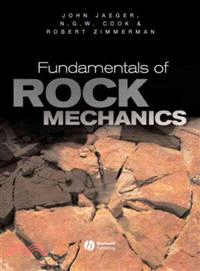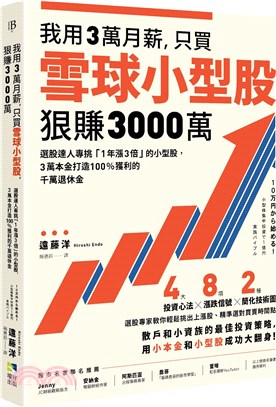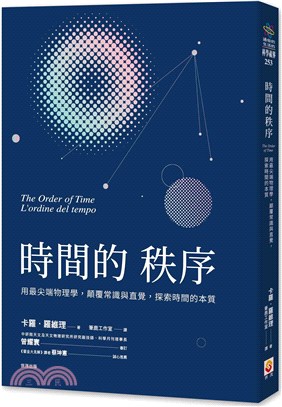Fundamentals Of Rock Mechanics 4E
商品資訊
商品簡介
- Extensively updated throughout, this new edition contains substantially expanded chapters on poroelasticity, wave propogation, and subsurface stresses
- Features entirely new chapters on rock fractures and micromechanical models of rock behaviour
- Discusses fundamental concepts such as stress and strain
- Offers a thorough introduction to the subject before expertly delving into a fundamental, self-contained discussion of specific topics
- Unavailable for many years, now back by popular demand.
An Instructor manual CD-ROM for this title is available. Please contact our Higher Education team at HigherEducation@wiley.com for more information.
Reviews:
“With this attention to detail, and rigorous adherence to clarity and exactness in description, this edition will consolidate the standing achieved by the earlier editions as a most authoritative and comprehensive book in its field. It will continue to serve as a leading reference work for geoscientists interested in structural geology, tectonics and petrophysics as well as for civil, mining and petroleum engineers.” (Petroleum Geoscience)
"...I consider this book to be an invaluable reference for studying and understanding the fundamental science at the base of rock mechanics. I believe this to be a must-have textbook and I strongly recommend it to anyone, student or professional, interested in the subject." (Rock Mechanics and Rock Engineering)
"An excellent book, very well presented, and is a must for the shelves of serious engineers and scientists active or interested in the fields of rock mechanics and rock engineering.... Highly recommended." (South African Geographical Journal, 2008)
作者簡介
Neville G. W. Cook received a BS and PhD in geophysics from the University of Witwatersrand. He was the founder and first director of the Mining Research Laboratory of the South African Chamber of Mines, and in 1971 he received the Gold Medal of the Scientific and Technical Societies, the highest scientific award in South Africa. He was Donald H. McLaughlin Chair in Mineral Engineering at the University of California at Berkeley, and was a member of the U. S. National Academy of Engineering.
Robert Zimmerman received BS and MS degrees from Columbia University, and a PhD from the University of California at Berkeley. He has been a staff scientist in the Earth Sciences Division of the Lawrence Berkeley National Laboratory, and Reader in Rock Mechanics at Imperial College, London. He is currently Professor of Engineering Geology at the Royal Institute of Technology in Stockholm, and co-editor of the International Journal of Rock Mechanics. He is also the author of the monograph Compressibility of Sandstones.
目次
1.1 Introduction.
1.2 Joints and faults.
1.3 Rock-forming minerals.
1.4 The fabric of rocks.
1.5 The mechanical nature of rock.
2. Analysis of Stress and Strain.
2.1 Introduction.
2.2 Definition of traction and stress.
2.3 Analysis of stress in two dimensions.
2.4 Graphical representations of stress in two dimensions.
2.5 Stresses in three dimensions.
2.6 Stress transformations in three dimensions.
2.7 Mohr’s representation of stress in three dimensions.
2.8 Stress invariants and stress deviation.
2.9 Displacement and strain.
2.10 Infinitesimal strain in two dimensions.
2.11 Infinitesimal strain in three dimensions.
2.12 Determination of principle stresses or strains from measurements.
2.13 Compatibility equations.
2.14 Stress and strain in polar and cylindrical coordinates.
2.15 Finite strain.
3. Friction on Rock Surfaces.
3.1 Introduction.
3.2 Amonton’s law.
3.3 Friction on rock surfaces.
3.4 Stick-slip oscillations.
3.5 Sliding on a plane of weakness.
3.6 Effects of time and velocity.
4. Deformation and Failure of Rock.
4.1 Introduction.
4.2 The stress-strain curve.
4.3 Effects of confining stress and temperature.
4.4 Types of fracture.
4.5 Coulomb failure criterion.
4.6 Mohr’s hypothesis.
4.7 Effects of pore fluids.
4.8 Failure under true-triaxial conditions.
4.9 The effect of anisotropy on strength.
5. Linear Elasticity.
5.1 Introduction.
5.2 Stress-strain relations for an isotropic linear elastic solid.
5.3 Special cases.
5.4 Hooke’s law in terms of deviatoric stresses and strains.
5.5 Equations of stress equilibrium.
5.6 Equations of stress equilibrium in cylindrical and spherical coordinates.
5.7 Airy stress functions.
5.8 Elastic strain energy and related principles.
5.9 Uniqueness theorem for elasticity problems.
5.10 Stress-strain relations for anisotropic materials.
6. Laboratory Testing of Rocks.
6.1 Introduction.
6.2 Hydrostatic tests.
6.3 Uniaxial compression.
6.4 Triaxial tests.
6.5 Stability and stiff testing machines.
6.6 True-triaxial tests.
6.7 Diametral compression of cylinders.
6.8 Torsion of circular cylinders.
6.9 Bending tests.
6.10 Hollow cylinders.
7. Poroelasticity and Thermoelasticity.
7.1 Introduction.
7.2 Hydrostatic poroelasticity.
7.3 Undrained compression.
7.4 Constitutive equations of poroelasticity.
7.5 Equations of stress equilibrium and fluid flow.
7.6 One-dimensional consolidation.
7.7 Applications of poroelasticity.
7.8 Thermoelasticity.
8. Stresses around Cavities and Excavations.
8.1 Introduction.
8.2 Complex variable method for two-dimensional elasticity problems.
8.3 Homogeneous state of stress.
8.4 Pressurised hollow cylinder.
8.5 Circular hole in a rock mass with given far-field principal stresses.
8.6 Stresses applied to a circular hole in an infinite rock mass.
8.7 Stresses applied to the surface of a solid cylinder.
8.8 Inclusions in an infinite region.
8.9 Elliptical hole in an infinite rock mass.
8.10 Stresses near a crack tip.
8.11 Nearly rectangular hole.
8.12 Spherical cavities.
8.13 Penny-shaped cracks.
8.14 Interactions between nearby cavities.
9. Inelastic Behavior.
9.1 Introduction.
9.2 Plasticity and yield.
9.3 Elastic-plastic hollow cylinder.
9.4 Circular hole in an elastic-brittle-plastic rock mass.
9.5 Perfectly plastic behavior.
9.6 Flow between flat surfaces.
9.7 Flow rules and hardening.
9.8 Creep.
9.9 Simple rheological models.
9.10 Theory of viscoelasticity.
9.11 Some simple viscoelastic problems.
10. Micromechanical Models.
10.1 Introduction.
10.2 Effective moduli of heterogeneous rocks.
10.3 Effect of pores on compressibility.
10.4 Crack closure and elastic nonlinearity.
10.5 Effective medium theories.
10.6 Sliding crack friction and hysteresis.
10.7 Griffith cracks and the Griffith locus.
10.8 Griffith theory of failure.
10.9 Linear elastic fracture mechanics.
11. Wave Propagation in Rocks.
11.1 Introduction.
11.2 One-dimensional elastic wave propagation.
11.3 Harmonic waves and group velocity.
11.4 Elastic waves in unbounded media.
11.5 Reflection and refraction of waves at an interface.
11.6 Surface and interface waves.
11.7 Transient waves.
11.8 Effects of fluid saturation.
11.9 Attenuation.
11.10 Inelastic waves.
12. Hydromechanical Behavior of Fractures.
12.1 Introduction.
12.2 Geometry of rock fractures.
12.3 Normal stiffness of rock fractures.
12.4 Behaviour of rock fractures under shear.
12.5 Hydraulic transmissivity of rock fractures.
12.6 Coupled hydro-mechanical behavior.
12.7 Seismic response of rock fractures.
12.8 Fractured rock masses.
13. State of Stress Underground.
13.1 Introduction.
13.2 Simple models for the state of stress in the subsurface.
13.3 Measured values of subsurface stresses.
13.4 Surface loads on a half-space: two-dimensional theory.
13.5 Surface loads on a half-space: three-dimensional theory.
13.6 Hydraulic fracturing.
13.7 Other stress measurement methods.
14. Geological Applications.
14.1 Introduction.
14.2 Stresses and faulting.
14.3 Overthrust faulting and sliding under gravity.
14.4 Stresses around faults.
14.5 Mechanics of intrusion.
14.6 Beam models for crustal folding.
14.7 Earthquake mechanics.
References
主題書展
更多書展本週66折
您曾經瀏覽過的商品
購物須知
外文書商品之書封,為出版社提供之樣本。實際出貨商品,以出版社所提供之現有版本為主。部份書籍,因出版社供應狀況特殊,匯率將依實際狀況做調整。
無庫存之商品,在您完成訂單程序之後,將以空運的方式為你下單調貨。為了縮短等待的時間,建議您將外文書與其他商品分開下單,以獲得最快的取貨速度,平均調貨時間為1~2個月。
為了保護您的權益,「三民網路書店」提供會員七日商品鑑賞期(收到商品為起始日)。
若要辦理退貨,請在商品鑑賞期內寄回,且商品必須是全新狀態與完整包裝(商品、附件、發票、隨貨贈品等)否則恕不接受退貨。
























